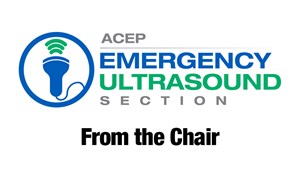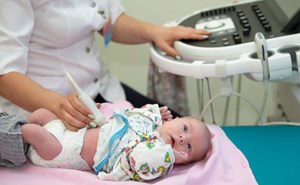
POCUS in Simulation: How to Incorporate and Publish Cases
Irini Agaraj, MD
Resident, Department of Emergency Medicine, Yale School of Medicine
Zachary Boivin, MD
Instructor, Department of Emergency Medicine, Yale School of Medicine
Edmund Hsu, MD, MSIDT, FPD-AEMUS
Assistant Professor, Department of Emergency Medicine, UC Irvine School of Medicine
Incorporation of POCUS into Simulation Cases
Ultrasound can be incorporated into simulation cases under the supporting documents/imaging section. Either still images or video clips can be utilized, but they require deidentification to ensure HIPAA compliance and that any DICOM metadata is removed. Images may be easily deidentified and cropped using the Core Ultrasound tool ClipDeidentifier.1 Point of care ultrasound (POCUS) can be incorporated into many different case types including trauma (FAST), cardiac arrest/chest pain (TEE or TTE), respiratory failure (lung), ectopic pregnancy (pelvic), cholecystitis (biliary), etc. Often, simulation patients are too unstable to travel to computed tomography (CT); think of a patient with a ruptured abdominal aortic aneurysm or a crashing trauma patient. If a learner needs to be guided to reach for POCUS, they may be prompted by a consultant or nurse, or the CT scanner may be occupied with another critical patient.
When thinking about POCUS competency, there are three essential skills for learners: image acquisition, image interpretation, and clinical integration. Image acquisition is difficult to simulate; traditionally, participants may be asked to practice obtaining images on a mannequin using a real ultrasound or a simulated probe. Technology such as an RFID reader has been proposed to test image acquisition and could be trialed.2 This can be difficult to see exactly where the learners are placing the probe while running the simulation case. Another option is to provide images to the learners if they ask for it, without testing acquisition skills. This is a less preferred method as it skips over the vital task of acquisition; but learners can be asked to describe what imaging planes and views they would obtain prior to providing the images. Participants should then be responsible for interpreting images within the clinical context of the case.
How to Recruit and Publish
The target audience for a simulation case is broad and can include residents, medical students, attending physicians, advanced practice providers (APPs), nursing, and emergency medical services (EMS). To recruit residents, consider offering hours they can use towards their didactic requirements or incorporate the case as part of a simulation rotation. To recruit medical students, cases may be offered as an optional educational experience during their EM rotation or away elective, or as part of an emergency medicine or simulation interest group. To expand to nursing staff/APPs/EMS, consider incorporating simulation cases during an orientation or training period. For a pilot/feasibility case, running a case through 10-20 participants should be sufficient for publication.
With simulation cases, image acquisition is difficult to study. Image interpretation and clinical integration are fundamental skills that can be studied. Outcomes can be measured through qualitative surveys or skills-based tests. The Objective Structured Clinical Examination (OSCE), a structured method to assess knowledge and clinical skills, may also be utilized. For instance, a simulation case may be run with and without POCUS, followed by administration of an OSCE for each group.
Case Templates
On the ACEP site, under the subcommittee section, you will find various simulation cases3. These can be used as a template for making your case
Journals
There are various journals that accept simulation/ultrasound cases. Depending on the target audience of the simulation case they range from educational journals, simulation journals, ultrasound journals, and multidisciplinary journals. Some have an article processing charge (APC) while others are free or free for non-open access publication.
Below is a table of journals that are PubMed indexed, have published simulation cases, and have a template available:
|
Journal |
APC req’d |
APC |
Impact factor |
Contact information |
Published Simulation Case |
Case Template |
|
MedEdPORTAL (AAMC) |
No |
$0 |
NA |
mededportal@aamc.org |
SHOCK! Three Simulated Case Series for Medical Students |
Mededportal.org, downloadable file |
|
JETem (Journal of Education & Teaching in Emergency Medicine) |
Yes |
$150 |
NA |
JETemOnline@gmail.com |
https://jetem.org/a_cold_case/ |
https://jetem.org/submit-to-jetem/simulation-submission-form/ |
Below is a table of journals that are PubMed indexed and accept simulation research:
|
Journal |
APC required |
APC |
Impact Factor |
Contact Information |
Example of Published Simulation Research |
|
Simulation in Healthcare |
No |
$0 |
1.7 |
admin@ssih.org |
Where to Begin: Utilizing In Situ Simulation as a Tool for Rapid Assessment of Current Practices in Trauma Management |
|
Advances in Simulation |
Yes |
$2790 |
2.9 |
Journalsubmissions@springernature.com |
Innovative approaches to pericardiocentesis training: a comparative study of 3D-printed and virtual reality simulation models |
|
The Clinical Teacher |
Yes |
$3620 |
1.4 |
tct@wiley.com |
Triaging in Mass Casualty Incidents: A Simulation-Based Scenario Training for Emergency Care Senior Residents |
|
Clinical Simulation in Nursing |
Yes |
$3210 |
3.1 |
US Elsevier Health Support Center |
Integration of Simulation to Prepare Adult-Gerontology Acute Care Nurse Practitioners |
|
Medical Teacher |
Yes |
$5520 |
3.3 |
med@mededuc.com |
High-fidelity simulation is superior to case-based discussion in teaching the management of shock |
|
Journal of Graduate Medical Education (JGME) |
No |
$0 |
0.75 |
jgme@acgme.org |
Just-in-Time Simulation Training to Augment Overnight ICU Resident Education |
|
Western Journal of Emergency Medicine |
Yes |
$1250 |
3.98 |
editor@westjem.org |
Simulation Improves Emergency Medicine Residents’ Clinical Performance of Aorta Point-of-Care Ultrasound |
|
Academic Emergency Medicine Education & Training |
No |
$3300 Open access |
3.01 |
cs-journals@wiley.com |
Simulation Training and Skill Assessment in Emergency Medicine |
|
Annals of Emergency Medicine |
No |
$0 |
5.0 |
https://service.elsevier.com/app/contact/supporthub/sciencedirect
|
362 Effectiveness of a One-day, Case-based, Hands-on Simulation Course for Enhancing Emergency Medical Services Provider Knowledge in Emergency Airway Assessment and Management |
|
Cureus |
No |
$0 |
1.2 |
support@cureus.com |
Knowledge Retention From Emergency Medicine Simulation-Based Learning Curriculum for Pre-clinical Medical Students |
|
BMC Medical Education |
No |
$2990 Open access |
2.7 |
https://support.springernature.com/en/support/tickets/new?ticket_form=journal_contact_form |
Effectiveness of simulation-based clinical research curriculum for undergraduate medical students - a pre-post intervention study with external control |
|
International Journal of Healthcare Simulation |
Yes |
$1910 |
NA |
editor@ijohs.com |
Do virtual placements work in nurse education? A cohort study into strengths and limitations |
|
Journal of Nursing Education |
No |
$0 |
1.6 |
Journal of Nursing Education |
Incorporating Scenario-Based Simulation Into a Hospital Nursing Education Program |
For any questions about simulation cases, opportunities to publish cases, or additional ideas for cases please contact Zachary Boivin or Edmund Hsu.
References
- Clip Deidentifier.
Accessed April 27, 2025 - Jaffa E. POCUSim – Everything Old is New Again. 2025.
Accessed April 27, 2025 - Simulation Cases.
Accessed April 27, 2025



